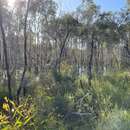Distribution and Habitat
provided by AmphibiaWeb articles
Lake Woongeel on Fraser Island, south-east coastal Queensland to Kurnell mid-eastern New South Wales. The extent of occurrence of the species is approximately 30300 km2.There is no information on population size, structure, dynamics, genetics, non-breeding habitat requirements or factors limiting distribution.
- Ehmann, H. (1997). Threatened Frogs of New South Wales: Habitats, Status and Conservation. Frog and Tadpole Study Group, New South Wales.
- Straughan, I.R. and Main, A.R. (1966). ''Speciation and polymorphism in the genus Crinia Tschudi (Anura, Leptodactylidae) in Queensland.'' Proceedings of the Royal Society of Queensland, 78(2), 11-28.
- author
- J.-M. Hero
- author
- H. Hines
- author
- E. Meyer
- author
- D. Newell
Life History, Abundance, Activity, and Special Behaviors
provided by AmphibiaWeb articles
In acid Melaleuca swamps, and wallum areas with poor drainage.Breeding occurs in July and August. Eggs are deposited in water with pH 4.3 – 5.2. More information in Straughan & Main (1966), Ingram & Corben (1975) and Ehmann (1977).
- author
- J.-M. Hero
- author
- H. Hines
- author
- E. Meyer
- author
- D. Newell
Life History, Abundance, Activity, and Special Behaviors
provided by AmphibiaWeb articles
Continuing decline in area of occupancy, number of locations, number of mature individuals. Severely fragmented habitat – it was assumed that the population is naturally fragmented, but increasing fragmentation through habitat destruction and degradation, particularly mainland populations.ThreatsLocalised extermination of populations due to loss or fragmentation of habitat.Conservation MeasuresListed as vulnerable and protected in some National Parks in both Queensland and New South Wales (including Fraser Island).
- author
- J.-M. Hero
- author
- H. Hines
- author
- E. Meyer
- author
- D. Newell
Wallum froglet
provided by wikipedia EN
The wallum froglet (Crinia tinnula) is a species of ground-dwelling frog native to the east coast of Australia, from southeast Queensland to Kurnell, NSW. It is strongly associated with Wallum swampland.
Description
This species is a small species of frog, up to 15 mm in length. It is very similar to the common eastern froglet, and can only readily be distinguished by call and a white stripe on the throat that reaches all the way to the tip on the snout. Its dorsal surface is variable, it can range from grey to brown and is normally smooth in texture. The dorsal surface can be spotted, plain, however it is normally striped. The ventral surface is faintly marbled black and white.
Ecology and behaviour
This species is confined to acid paperbark swamps in wallum country. Males make a high pitched squeaking noise and call at any time of the year, when water is available. Males normally call from hidden positions in grass, while floating in the water. Breeding happens mostly during autumn and winter and occurs in large swamps and temporary ponds fringing the swamp. Eggs are laid singly on twigs and leaves in still water. Tadpoles are brown with arched tail fins, reaching almost 40 mm in size. Tadpole development takes nearly 6 months, with metamorph frogs ranging from 6–11 mm.
The swamps that these frogs inhabit are coming under increasing threat by urbanisation.
Sources
- Anstis, M. 2002. Tadpoles of South-eastern Australia. Reed New Holland: Sydney.
- Robinson, M. 2002. A Field Guide to Frogs of Australia. Australian Museum/Reed New Holland: Sydney.
-
Frog Australia Network-frog call available here.

- license
- cc-by-sa-3.0
- copyright
- Wikipedia authors and editors
Wallum froglet: Brief Summary
provided by wikipedia EN
The wallum froglet (Crinia tinnula) is a species of ground-dwelling frog native to the east coast of Australia, from southeast Queensland to Kurnell, NSW. It is strongly associated with Wallum swampland.
- license
- cc-by-sa-3.0
- copyright
- Wikipedia authors and editors

